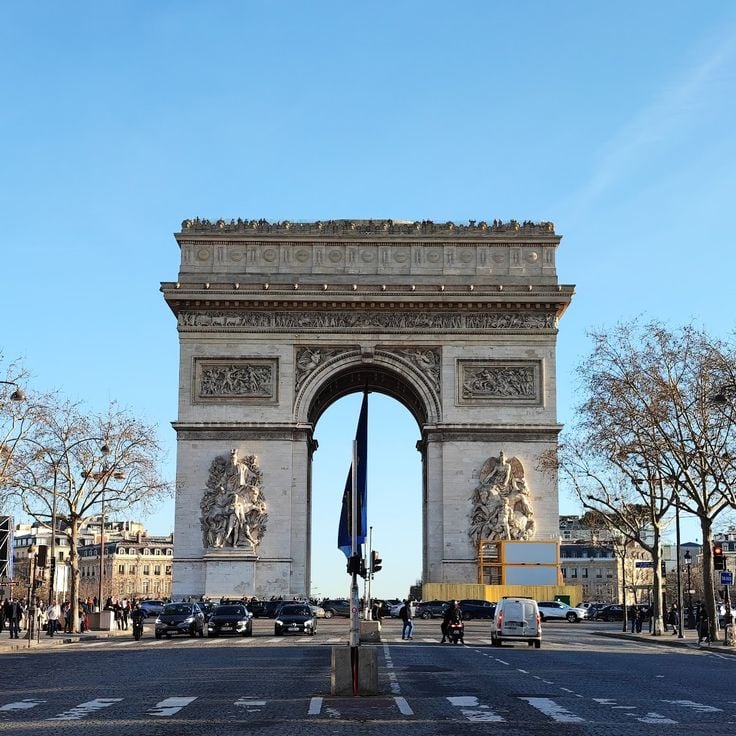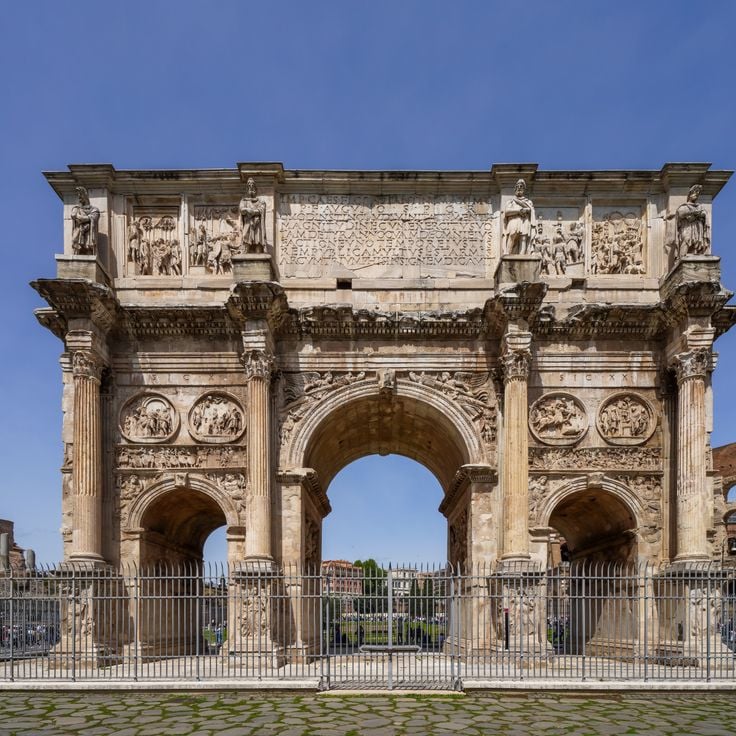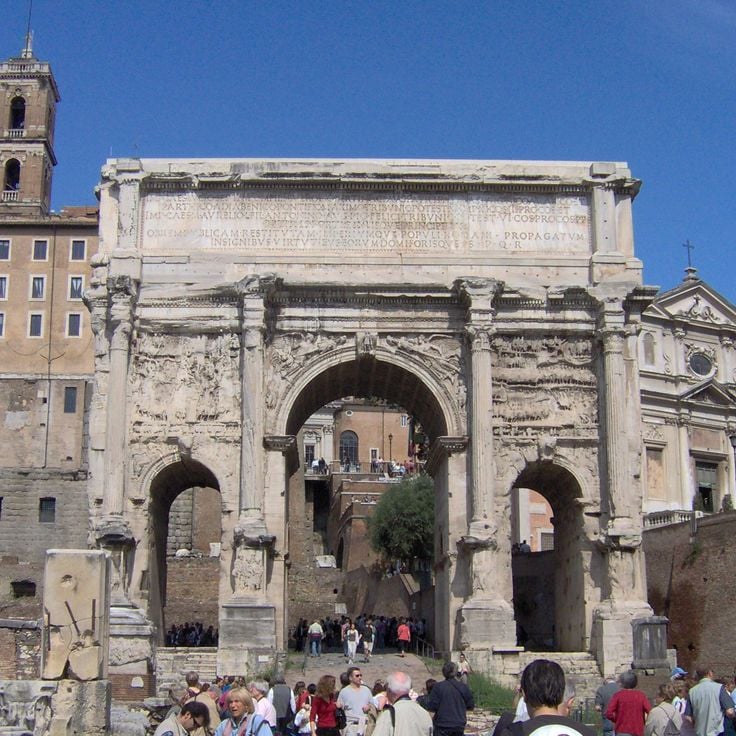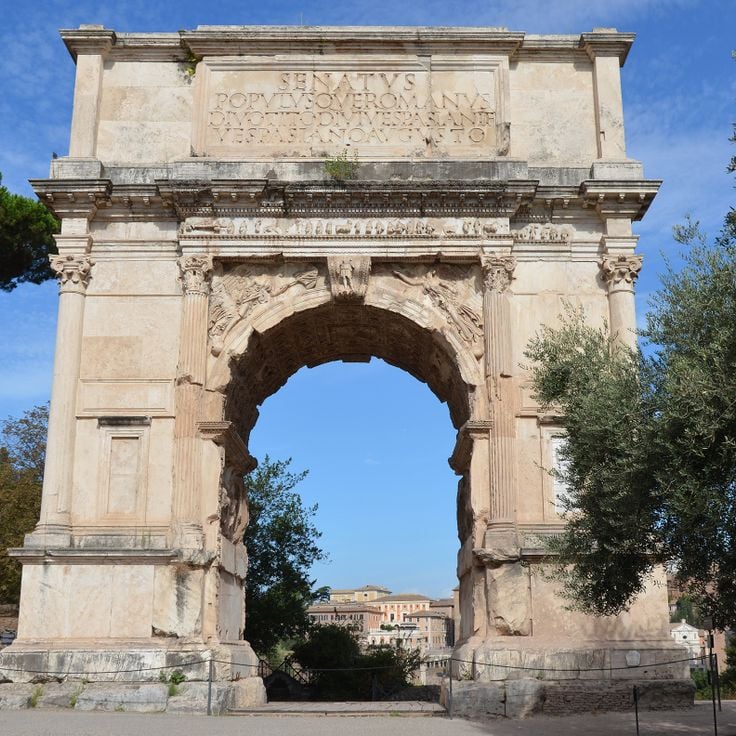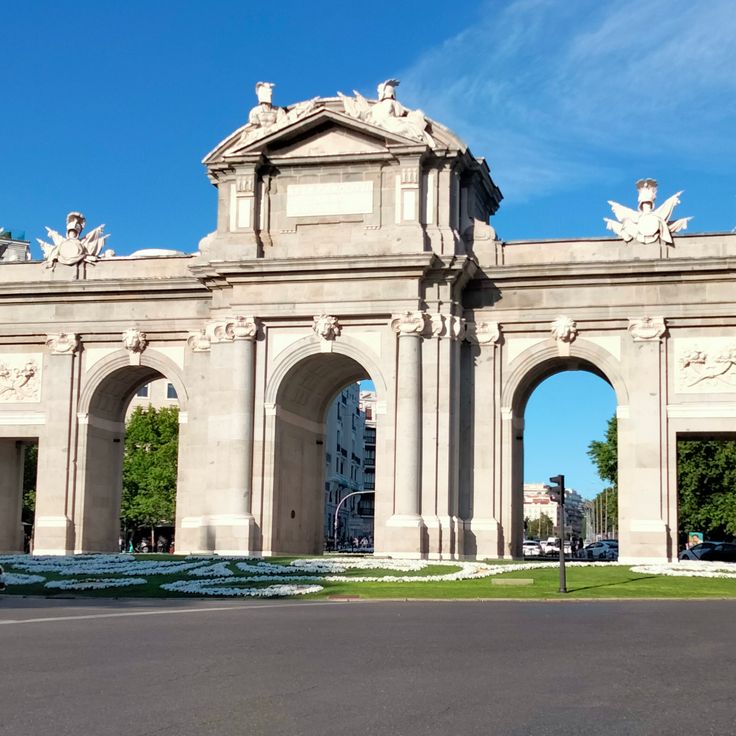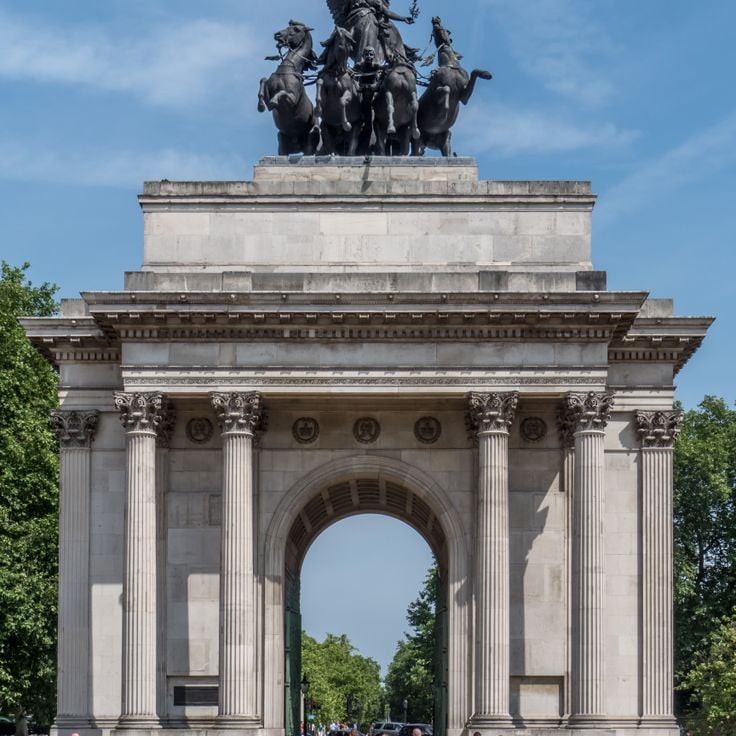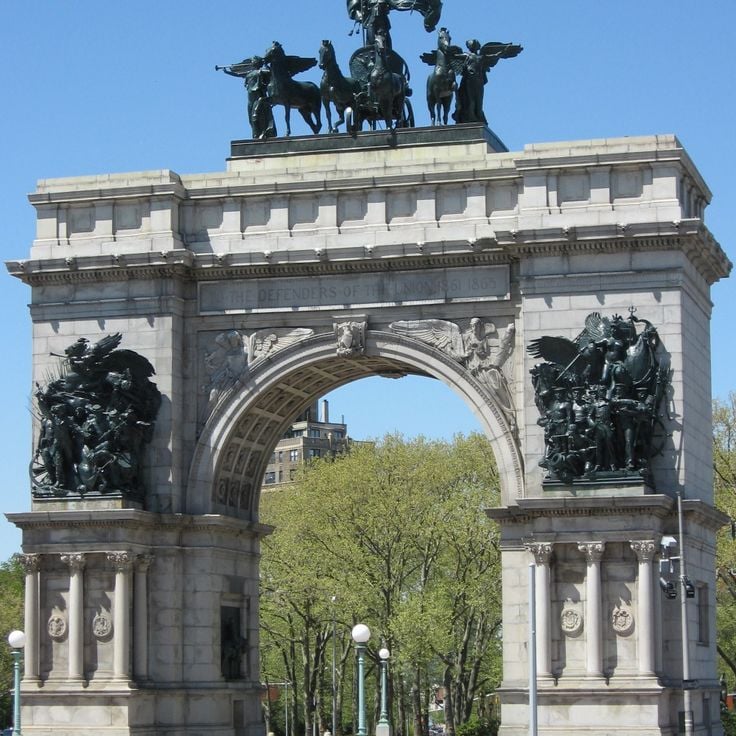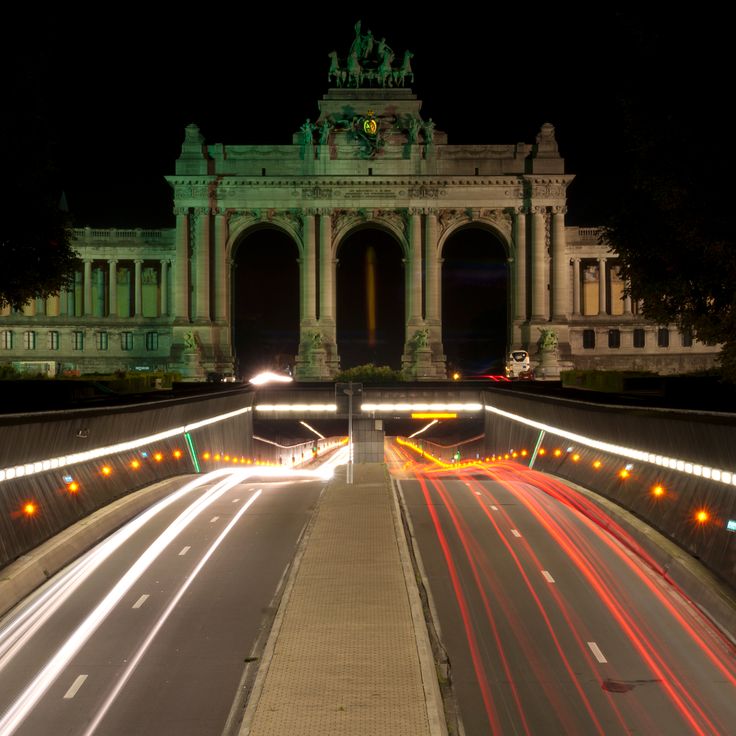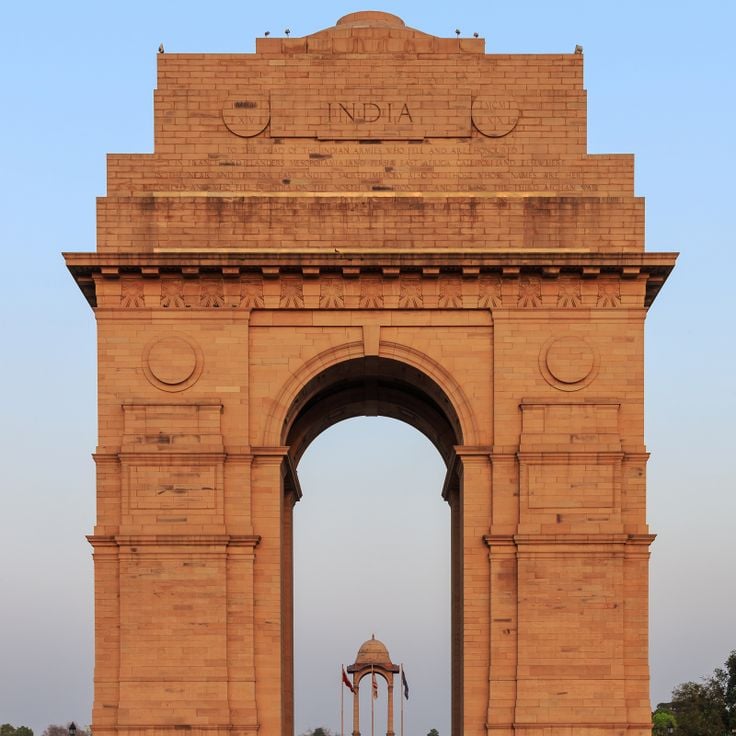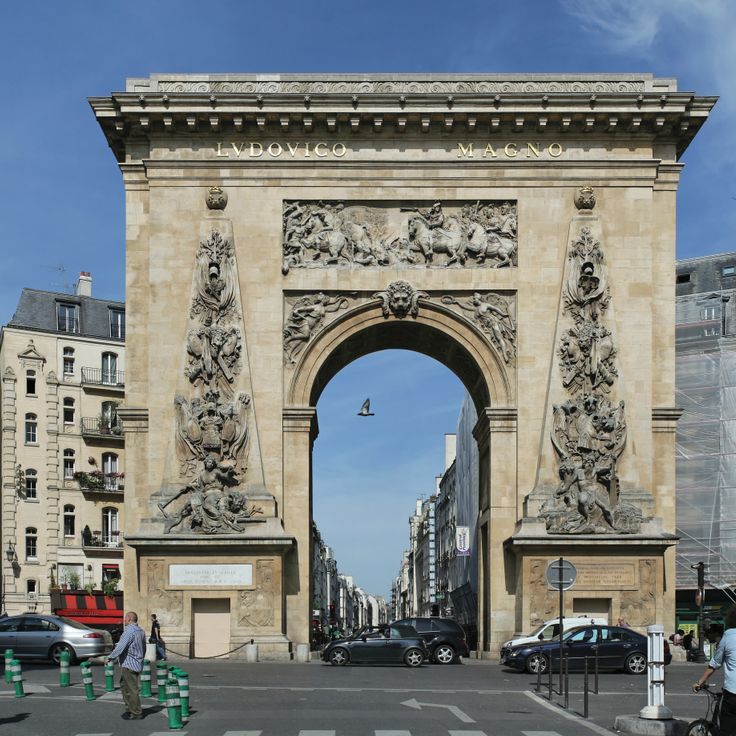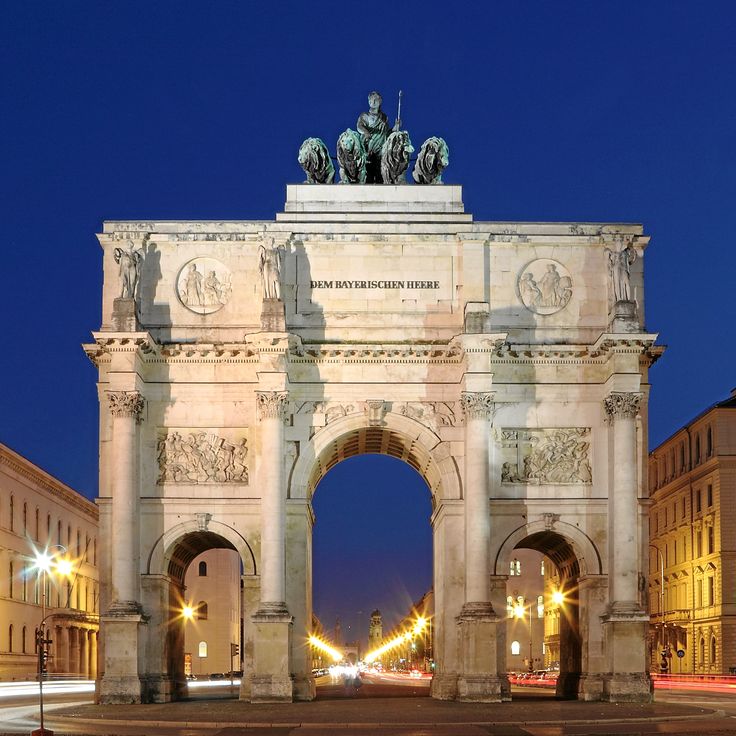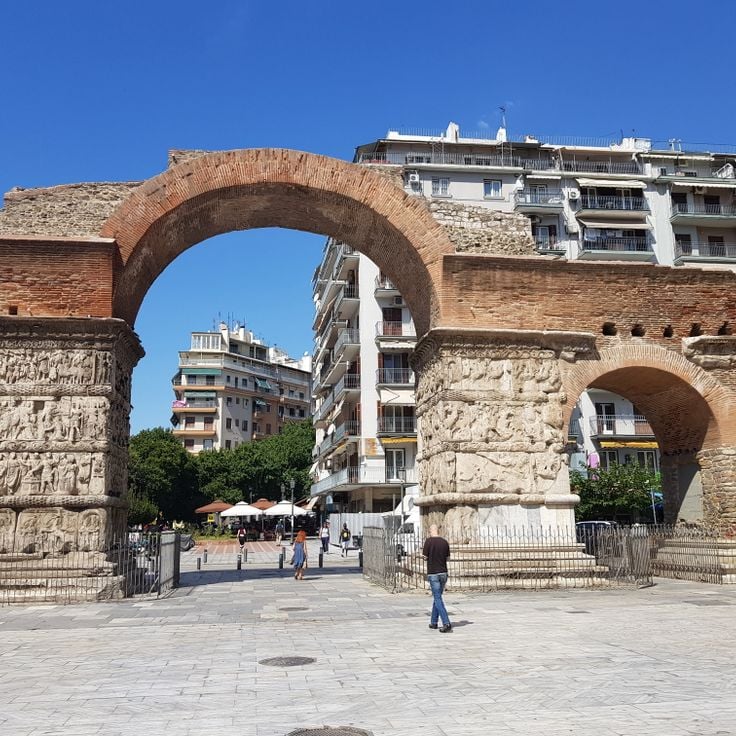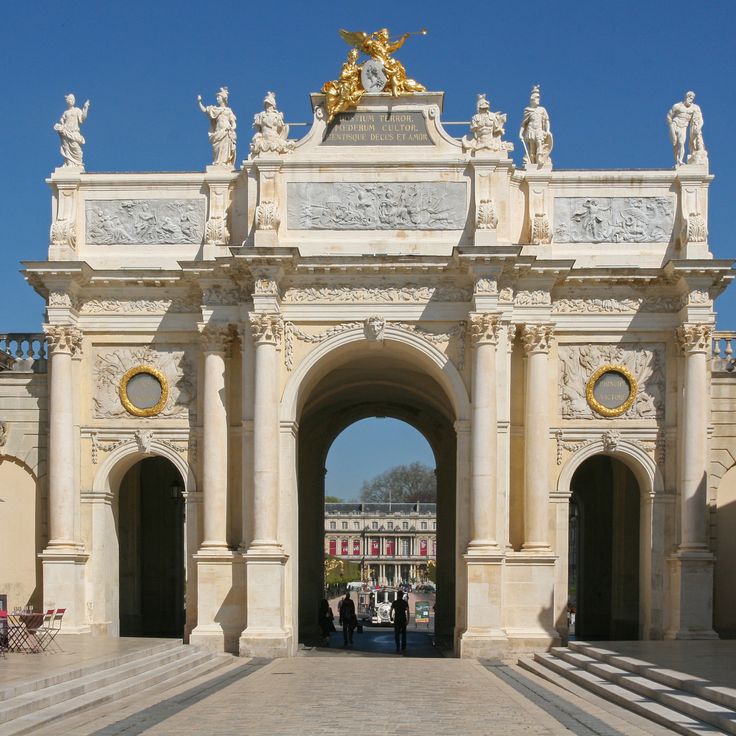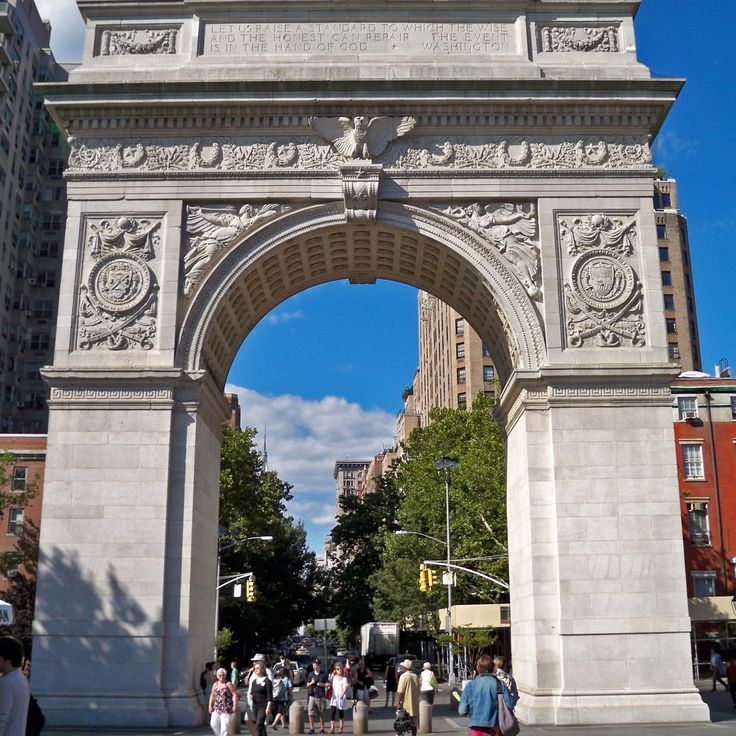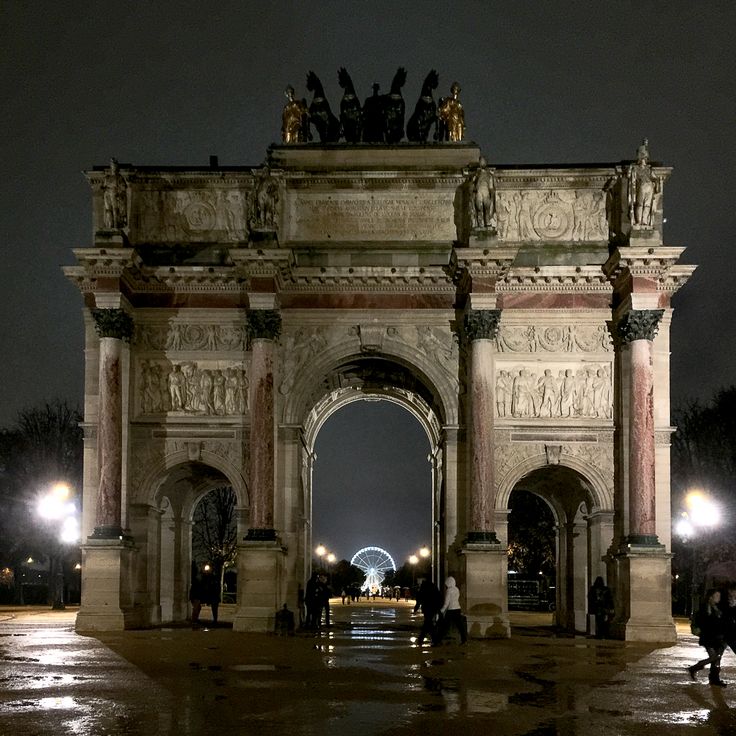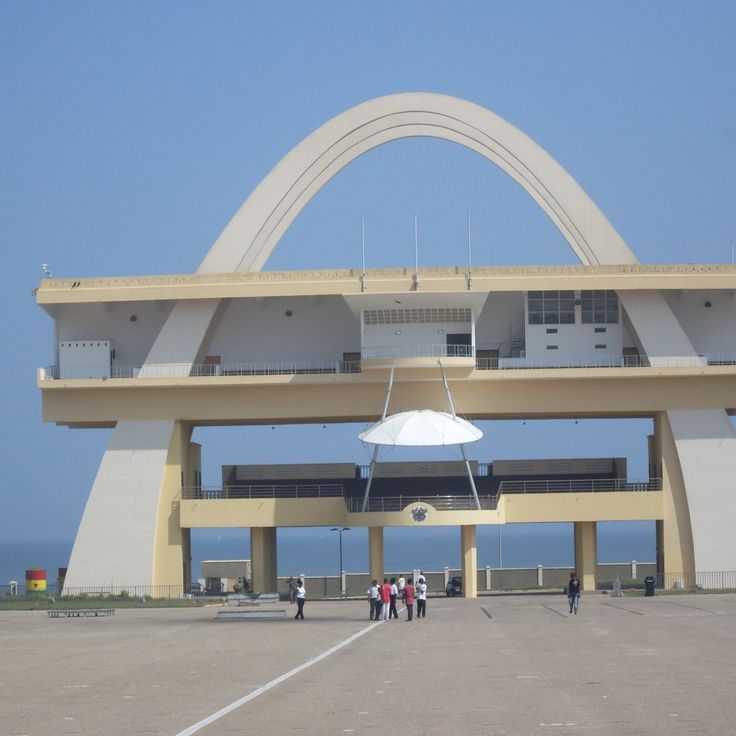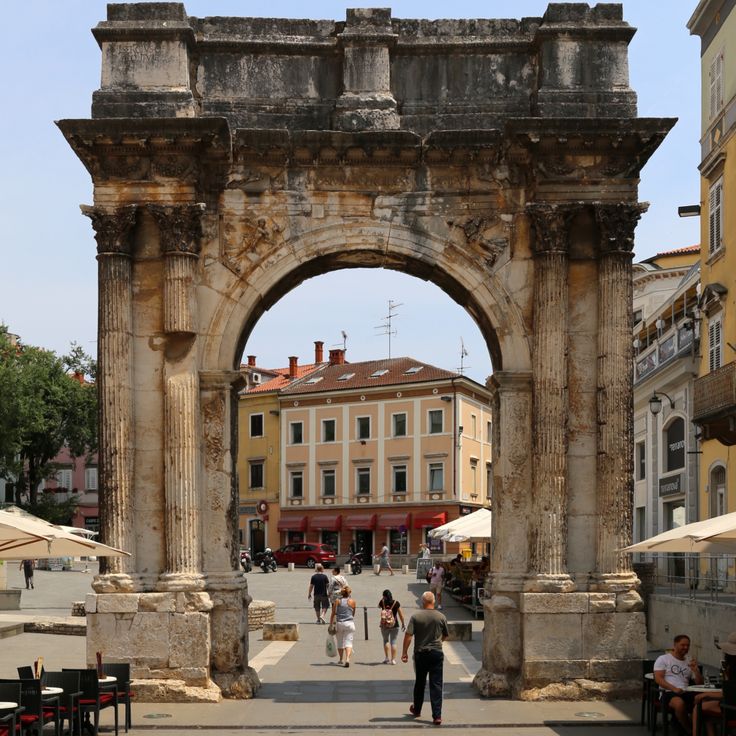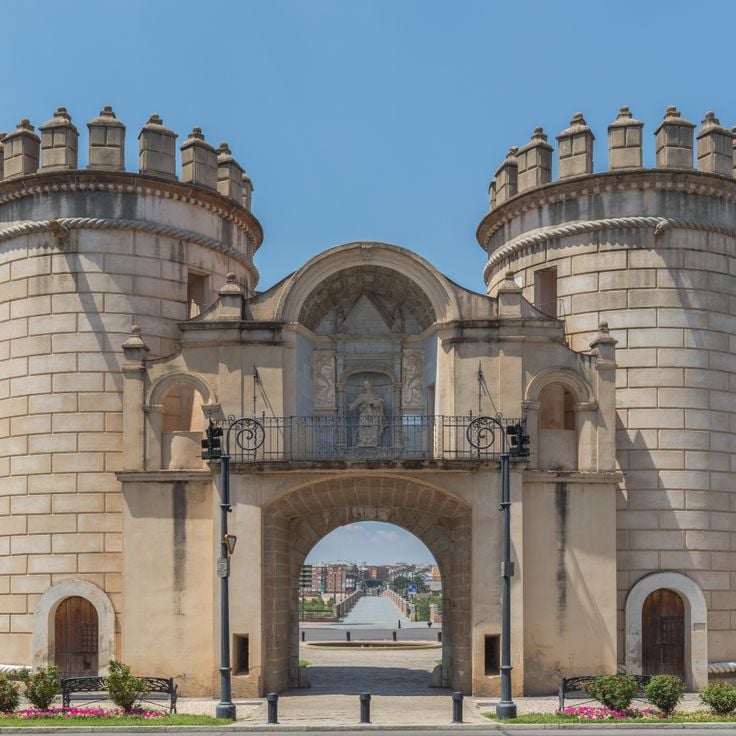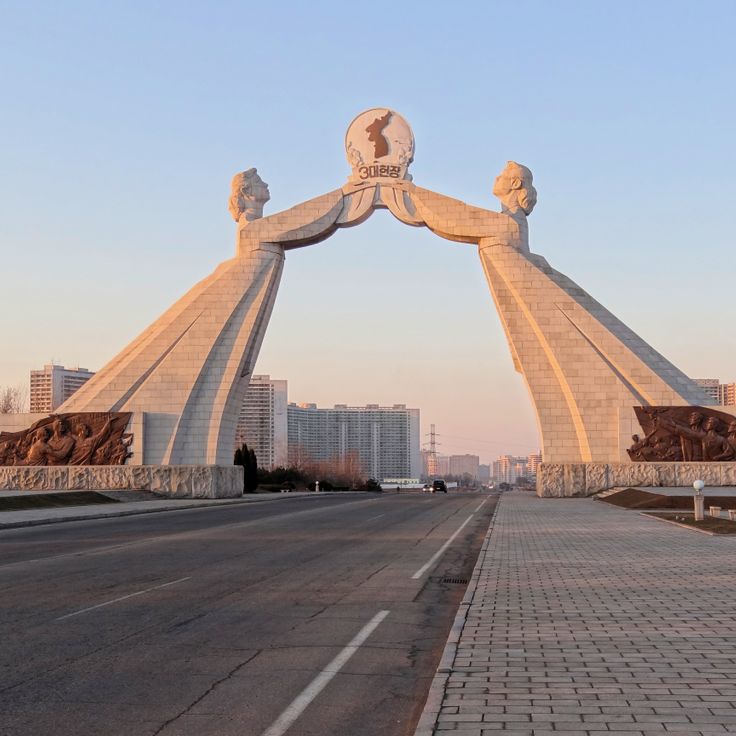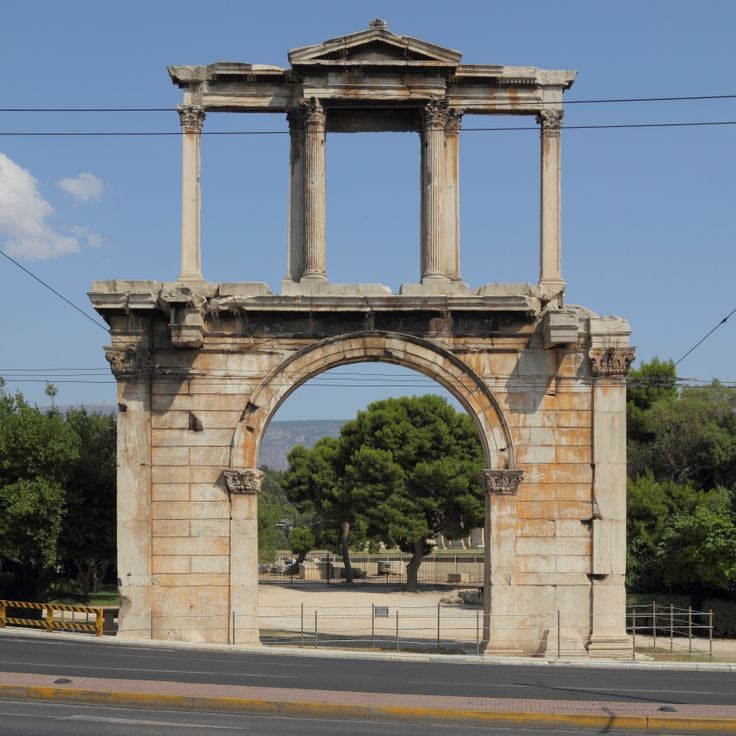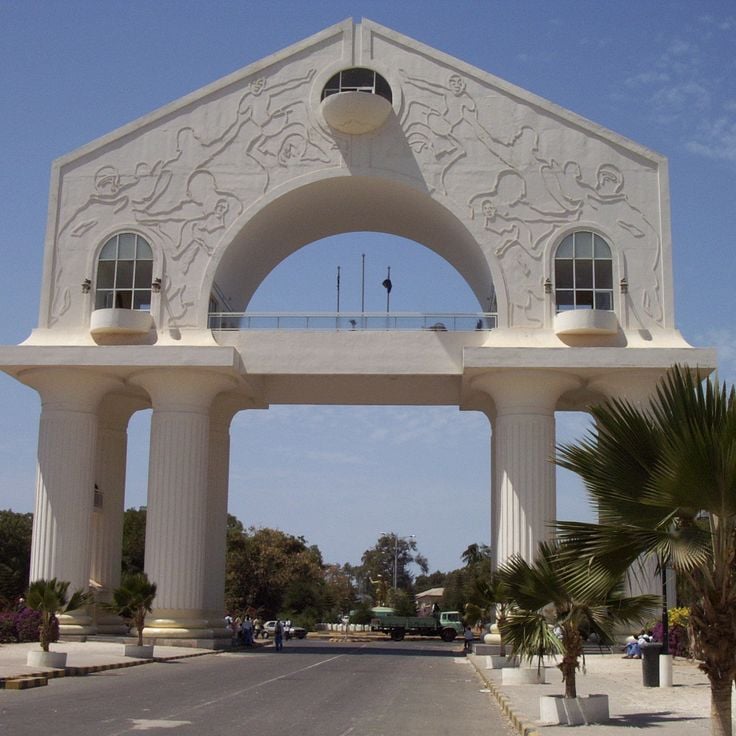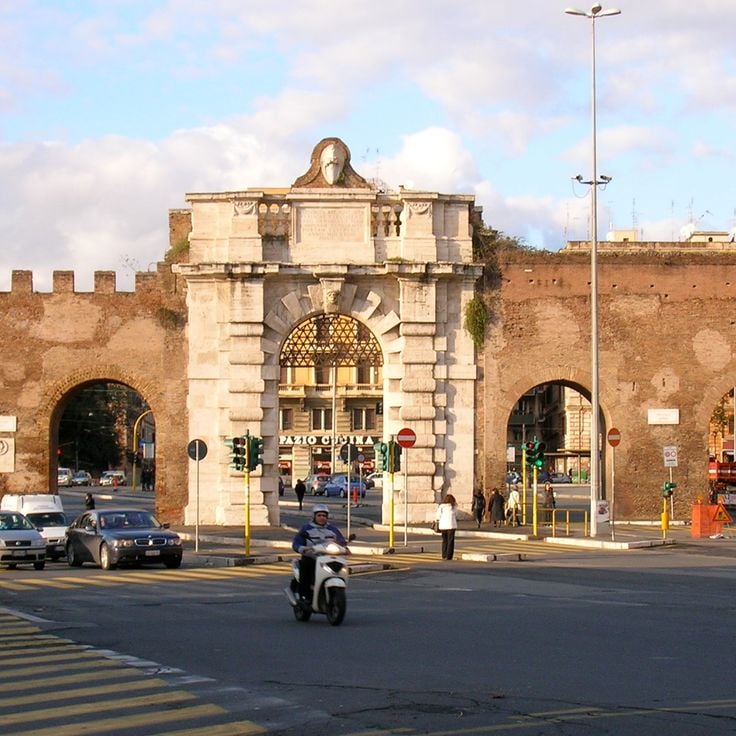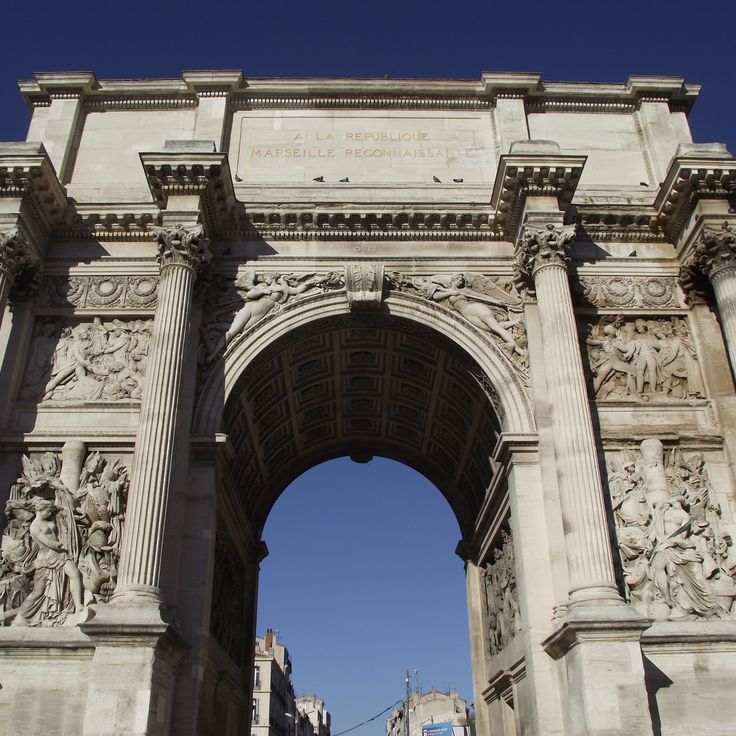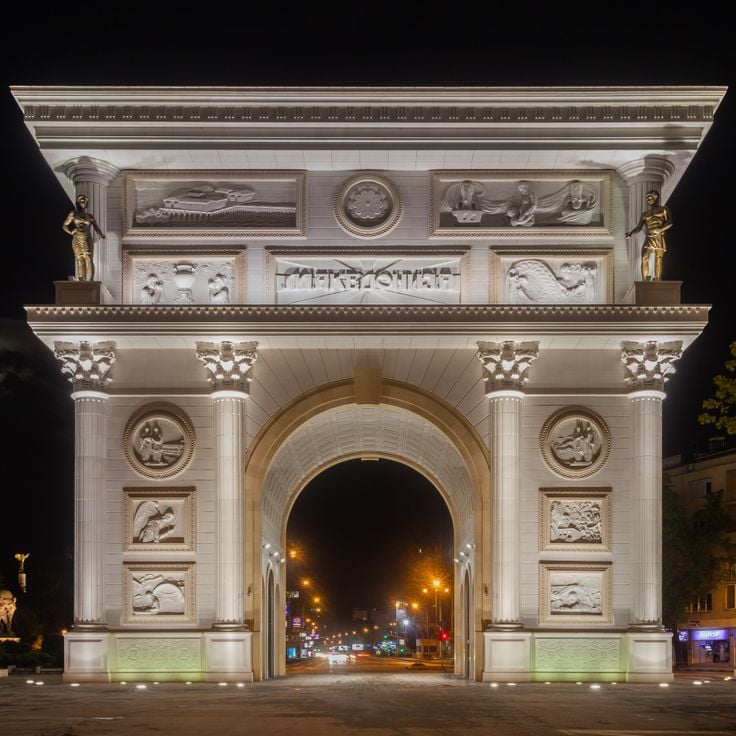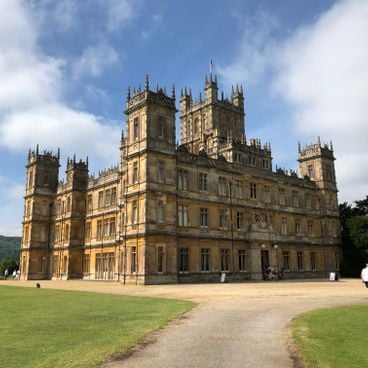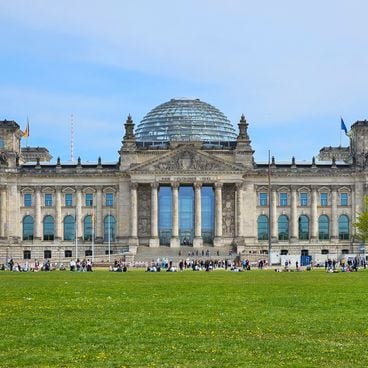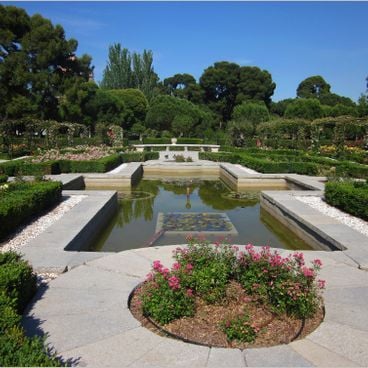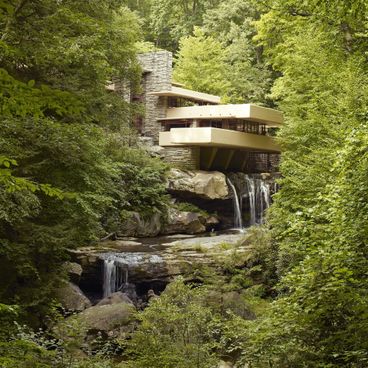Triumphal arches document military and historical events of their time. These monuments to victories and commemoration stand in cities around the world. The structures combine architectural elements with historical documentation through reliefs, inscriptions, and sculptures. The collection includes Roman triumphal arches such as the Arch of Constantine, Arch of Titus, and Arch of Septimius Severus in Rome, along with the Arch of Trajan in Benevento. Paris features the Arc de Triomphe, Porte Saint-Denis, and Arc de Triomphe du Carrousel. The Brandenburg Gate in Berlin, Siegestor in Munich, and Puerta de Alcalá in Madrid document European history. Further examples include the India Gate in New Delhi, Patuxaï in Vientiane, and Arch 22 in Banjul. In North America, the Washington Square Arch and Soldiers' and Sailors' Arch stand in New York, while the Gateway Arch rises in St. Louis. The Triumphal Arch of Orange and Hadrian's Arch in Athens demonstrate ancient Roman architecture.
The Arc de Triomphe in Paris is a 164 foot (50 meter) tall monument standing at Place Charles de Gaulle that celebrates French military history. The structure documents major battles through detailed reliefs and displays engraved names of generals and fallen soldiers. Four large pillars support sculptural groups representing pivotal moments in French military campaigns. Beneath the vault lies the Tomb of the Unknown Soldier with its Eternal Flame, rekindled daily since 1920. The platform offers access to historical exhibition rooms and viewing points overlooking the twelve Parisian boulevards that radiate from this location.
The Brandenburg Gate was built between 1788 and 1791 following designs by Carl Gotthard Langhans in the Neoclassical style. The structure rises 26 meters (85 feet) above Pariser Platz and features twelve Doric sandstone columns forming five passageways. The quadriga atop the attic shows Victoria, goddess of victory, driving a chariot drawn by four horses. Johann Gottfried Schadow created this copper sculpture in 1793. Reliefs on the inner wall surfaces depict scenes from Greek mythology, including the Hercules cycle. The gate originally served as one of eighteen city gates and marks the western entrance to Unter den Linden boulevard. In this collection of triumphal arches, the Brandenburg Gate represents a key monument that combines architectural achievement with historical documentation.
This triumphal arch was erected in 315 to celebrate Emperor Constantine's victory over Maxentius. The monument combines architectural elements from different periods of Roman history. Its reliefs and sculptures were taken from older monuments and reassembled here. The arch stands between the Colosseum and the Palatine Hill and documents through its inscriptions and imagery important military events of the early 4th century.
The Arch of Septimius Severus is a triumphal arch that documents military victories and historical events of its time. This 75-foot tall structure was erected in 203 AD to honor Emperor Septimius Severus and his sons following successful campaigns against the Parthians. The three-passage arch features detailed relief panels depicting military campaigns in the Middle East, including sieges of Mesopotamian cities. Inscriptions on the attic level record the military achievements and political events of the Severan dynasty.
The Arch of Titus from 82 AD stands in the Roman Forum and displays reliefs of the sack of Jerusalem. This triumphal arch was erected after the death of Emperor Titus to honor his military achievements in the Jewish War. The relief carvings document the transport of spoils from the destroyed Second Temple, including the menorah and other religious objects. The inscriptions describe the emperor's victories over the Jewish people. As one of the earliest surviving Roman triumphal monuments, the arch served as a model for later commemorative structures throughout Europe and beyond.
The Gate of Alcalá is an 18th-century city gate in Madrid that documents the architectural development of the city during the reign of Charles III. Designed by Francesco Sabatini, this structure is built from granite and features five decorative arches. The monument combines neoclassical elements with baroque details and displays reliefs and ornamentation representing military victories and historical events of the Spanish monarchy. Originally serving as one of the main entrances to the city, it marked the road to Alcalá de Henares. The three central arches feature semi-domes, while the two side arches have flat architraves.
The Wellington Arch stands at Hyde Park Corner in London and was built in 1830. This triumphal arch in Corinthian style has three passageways and is topped by Europe's largest bronze sculpture group, a chariot pulled by horses with Nike, the goddess of victory. Originally designed as a northern entrance to Buckingham Palace, it was later dedicated to honor the military victories of the Duke of Wellington. Inside, the arch contains exhibitions about its history and design. The upper levels offer views across the surrounding parks and historic neighborhoods of London.
The Soldiers' and Sailors' Arch documents military and historical events in this collection of triumphal monuments. Built in 1892 in Brooklyn, the structure stands at Grand Army Plaza and honors the soldiers and sailors of the Union Army who served in the American Civil War. Relief sculptures depict Abraham Lincoln and Ulysses Grant, two central figures of the Union's efforts during the conflict. This arch serves as a memorial to Civil War participants and records the military history of the United States from the mid-19th century.
This triumphal arch in Brussels stands as a monument to military victories and national history. Completed in 1905, the structure houses the Art and History Museum and the Automobile Museum. The arch marks the entrance to Cinquantenaire Park and originally served as a gateway for the 1880 Brussels World's Fair. The facade displays allegorical sculptures and reliefs representing Belgium's historical provinces and documenting national themes. The arch connects two building complexes and forms the architectural center of the park.
This India Gate is a red sandstone monument that honors soldiers who fell in historical wars. The structure displays features of a triumphal arch with an arched passage and flat roof. Edwin Lutyens designed this work, which was completed in 1931. At its center burns a flame dedicated to fallen soldiers. Reliefs and inscriptions tell the story of military events from that era. The monument rises at the end of Rajpath and has become a defining landmark of New Delhi.
The Gateway Arch in Saint Louis documents the westward expansion of the United States. This 192-foot (59-meter) steel structure was completed in 1965 and stands along the Mississippi River. The monument combines modern engineering with historical meaning, showing the territorial development of the country during the 19th century. An observation platform at the top lets visitors view the river landscape and the city.
The Porte Saint-Denis was built in 1672 and marks the former boundary of Paris. This gate commemorates Louis XIV's Rhine campaign and documents this military operation through architectural design and historical inscriptions. The structure stands as a stone record of 17th-century French military history and the territorial development of the city. It combines functional elements of a city gate with the representation of historical events and belongs to the tradition of French triumphal monuments.
The Siegestor documents Bavaria's military history and serves as a memorial to the devastating consequences of war. This triumphal arch was completed in 1852 according to designs by Friedrich von Gärtner for King Ludwig I and features reliefs of Bavarian soldiers as well as a Bavaria figure with lion team. The monument suffered heavy damage during World War II and was deliberately only partially restored. The inscription 'Dedicated to victory, destroyed by war, urging peace' emphasizes its new meaning as a peace symbol. The Siegestor combines neoclassical architecture with historical documentation and stands at the northern end of Ludwigstrasse.
The Arch of Galerius in this collection of triumphal monuments documents military victories and historical events through stone and sculpture. Built in Thessaloniki during the early 4th century, this arch celebrates Emperor Galerius's victory over the Sassanid Persians. The surviving pillars display detailed reliefs depicting battle scenes, processions, and imperial ceremonies that record a Persian campaign from 297-298 AD. Originally part of a larger architectural complex linking the imperial palace to a mausoleum, the arch stood on the Via Egnatia, the main Roman road through the Balkans, serving as a symbolic entrance to imperial power.
The Patuxaï in Vientiane honors those who fought for independence from France. This monument stands in the capital as a commemoration of the Lao struggle for sovereignty. The structure combines traditional Lao architectural motifs with a design reminiscent of European triumphal arches. Four arches support the monument, which rises 148 feet (45 meters) above the city. Relief sculptures and decorative elements display mythological figures and scenes from Lao history. Visitors can climb to the upper levels for views across the capital.
This triumphal arch stands on Place Stanislas within this collection of monuments that document military events and historical moments. Built in the 18th century, it honors King Louis XV and records the relationship between the Duchy of Lorraine and the French crown. The Héré Arch combines classical architectural elements with historical inscriptions and decorative reliefs depicting military achievements. As part of the UNESCO World Heritage listing of Place Stanislas, it forms part of a neoclassical ensemble that shapes the urban center of Nancy.
This massive monument stands at Revolution Square in Mexico City and was originally conceived as part of a legislative palace before being transformed into a memorial after the Mexican Revolution. The steel and stone structure reaches 67 meters (220 feet) in height and features a central dome with four corner pillars. Sculptures at the base represent Independence, Law, Agrarian Reform, and Labor. The monument houses the remains of several Mexican revolutionary leaders, including Francisco Madero, Venustiano Carranza, and Pancho Villa. An observation deck provides panoramic views of the city.
This triumphal arch in Greenwich Village was built to commemorate the centennial of George Washington's inauguration in 1789. Constructed from white marble, the arch stands at the northern entrance to Washington Square Park and replaced an earlier temporary wooden structure from 1889. Designed by architect Stanford White, the monument was completed in 1892 and features classical Corinthian columns with sculptures depicting Washington as both general and president. The arch documents the early history of the American republic through its inscriptions and architectural design and has served as a central gathering point in Manhattan for over a century.
The Arc de Triomphe du Carrousel in Paris documents military victories under Napoléon I. Built between 1806 and 1808, this monument stands in the Jardin des Tuileries between the Louvre and Place de la Concorde. The arch features eight pink marble columns in the Corinthian order, framing three passageways. Reliefs on its walls show scenes from battles like the Battle of Austerlitz and the Peace of Pressburg. A gilded quadriga with four horses, originally from the Basilica of St. Mark in Venice, crowns the top of the structure.
This arch commemorates Ghana's independence, which the country achieved in 1957 from British colonial rule. The Independence Arch stands in central Accra and was built to celebrate the founding of the first republic in sub-Saharan Africa. The monument combines modern design with references to national history and marks a turning point in the African independence movement. It serves as a memorial to the decolonization events that shaped the West African nation and the beginning of a new chapter for Ghana.
The Triumphal Arch of Sergius was built in 27 BC in Pula and documents significant military events from the Roman era. This arch honors historical victories through detailed reliefs depicting chariots and horses. The structure combines Roman construction with historical documentation and serves as a monument to commemoration. The carvings show military scenes that help us understand the events of that period. The arch stands in the Croatian city of Pula and is among the preserved Roman monuments of this region.
This gate with two towers was built in 1551 and defended the bridge over the Guadiana River. The Puerta de Palmas documents the military significance of Badajoz during the Renaissance period and combines defensive function with monumental architecture. The structure reflects the strategic location of the city on the border river between Spain and Portugal. The two flanking towers formed part of the urban fortifications and controlled access to the city via the important river crossing.
The Arc de Triomphe de Kim Il-sung is a stone arch completed in 1982 to mark the 70th birthday of Kim Il-sung and reaches 60 meters in height. This monument documents North Korea's political history through its monumental architecture and honors the role of the state founder. Located in central Pyongyang, it features inscriptions and decorative elements relating to historical events of the nation.
The Arch of Reunification stands in Pyongyang and was built in 2001 to honor a meeting between high-ranking officials from North and South Korea. The structure shows two women in traditional Korean dress holding a sphere that represents the Korean Peninsula. The figures reach 98 feet (30 meters) in height and are made from over 100 concrete blocks. This monument documents diplomatic efforts toward reunification on the Korean Peninsula in the early 21st century and sits on the highway between Pyongyang and the demilitarized zone at the border with South Korea.
The Triumphal Arch of Orange is a Roman monument built between 10 and 27 BC. The north face shows a battle between Romans and Gauls. The reliefs on the facades depict weapons, captives, and battle scenes. The arch marked the entrance to the Roman colony and stood on the former Via Agrippa. This structure documents Roman military dominance in the region and remains among the preserved Roman monuments in southern France.
The Arch of Trajan in Benevento is a marble monument that documents Emperor Trajan's reign. Relief panels on the structure show his military successes, administrative reforms, and construction projects. This arch stands along the ancient Via Traiana, an important trade route to Brundisium. The detailed carvings on both sides of the monument record significant events from the Roman period. The arch demonstrates Benevento's strategic importance in the ancient Roman world.
This triumphal arch in Athens was built from Pentelic marble and erected in 131 AD at the boundary between the ancient city and the Roman expansion under Emperor Hadrian. The structure displays two inscriptions identifying the two parts of the city and connecting the rule of Theseus with that of Hadrian. The arch marked the transition between historic Athens and the new quarter that included buildings such as the Temple of Olympian Zeus.
This arch in Banjul was built in 1996 and stands 35 meters tall as a steel structure. It marks the military coup of July 22, 1994, and documents a turning point in Gambian history. Inside, an elevator carries visitors to an observation gallery that offers views over the city and surrounding landscape. The monument combines modern construction methods with the historical function of commemorating an important national event.
This stone gate was built in the 1570s and stands in the Aurelian Walls near Rome's cathedral. The Porta San Giovanni marks a historic entrance from the Via Appia Nuova and documents the city's military defense architecture. The gate connects architectural elements with the history of Roman city fortifications, showing how the city protected its boundaries.
The Porte d'Aix is a marble arch from 1839 that stands at the former city entrance on the road to Aix-en-Provence. This triumphal arch combines classical architectural elements with military decorations and documents the historical significance of this route into the city. The structure marks an important access point to Marseille during the 19th century and reflects the European tradition of arches that commemorate victories and historic events.
Porta Macedonia is a triumphal arch built in 2012 in Skopje, fitting within this collection of such monuments that document military and historical events. The structure is made of marble and bronze and displays reliefs depicting historical events from the region. Interior exhibition spaces across multiple levels convey regional history through sculptural representations and architectural design.
